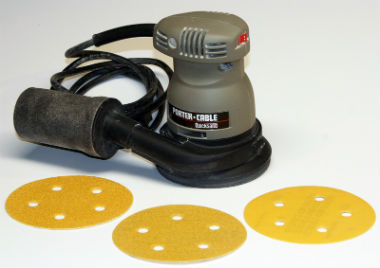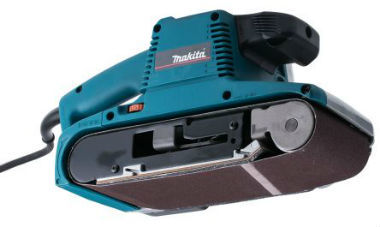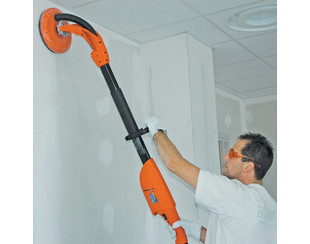
If you love woodworking, you know how crucial the final finishing step is to the quality of the final product. All that hard work preparing, assembling the pieces and fastening them together all led to the last step – putting a smooth, professionally finished surface on your project.
Strictly speaking, having a sander or not will not necessarily keep you from putting a good finish on your project – after all, you can always take some sandpaper sheets and sand the whole thing by hand.
Sanding, however, can be one of the biggest time sinks in any woodworking projects. You will know it if you have worked on a larger project, or went for a finish that required you to use different grades of sandpaper.
Having a power sander is an investment that pays off in terms of more time for you to check the fit and finish of your project, instead of spending your day sanding it all over. A sander not only lets you do the job faster, but it also lets you get consistent sanding results every time.
Choosing The Right Type of Sander
Sanding is such a labor-intensive part of woodworking that manufacturers have come up with several types of sanders to cover various stages of the process. From initial rough sanding to the fine detailing jobs on the corners and inlays, there’s a sander designed for the task.
Handheld Sanders
Handheld sanders are models that most of us are familiar with and these are usually smaller, more lightweight units that take the sander to the work piece.
They are typically gripped above the base and supported by a hand rest above for two-handed operation, although some models come with D-shaped handles or grips, especially in the case of the more powerful belt sanders.
Features to look for
- Two-step switch activation adds an extra layer of safety. You don’t want your sander spinning as soon as you plug it in just because you forgot to switch it to off.
- Clamps and stands let you use some models upside down as a benchtop sanding stand.
- Tracking adjustment features let you fine adjust the tracking to keep belt loops running straight (belt sanders).
- Dust collection features can be as simple as a small soft bag attached to an outlet port, but even this goes a long way to simplifying clean up.
- Simple sandpaper changing systems help increase your productivity by allowing you change paper faster with less steps involved in the process.
- Variable speed adjustments let you control the rate at which the sander takes off material and gives you much more control in the sanding process.
Different handheld sander types take different forms of sandpaper – sheet, round pads or belts. Like most handheld power tools, handheld sanders also come in different power types – corded, battery-powered, or pneumatic.
Handheld Sheet Sanders Are Nice To Have
For economical all-purpose sanding, most workshops can benefit from the flexibility of sheet sanders.
They can take the same standard sandpaper sheets that you use and rub it back and forth, much the same way that you will sand the piece by hand.
These types of sanders are my favorite type and it seems that they are the most economical when it comes to buying sandpaper.

makita.com
Depending on their size, sheet sanders can take 1/4, 1/3 or ½ of a sheet of sandpaper. Their simple operation and versatility also let them use sandpaper meant for paint, plastic, and metals as well. They are also some of the cheapest power sanders you can buy.
Handheld Random Orbit Sanders
Random orbit sanders work very much like sheet sanders, except they use round sandpaper discs that the tool spins at high speeds.
They also add a random oscillation along with the rotation to minimize the risk of swirls and gouges, leading to a little better, overall finish.

For the final stages of a project just before staining, a random orbit sander combined with fine grit sandpaper discs is the tool for the job.
Note that the special sanding paper sheets are a bit more expensive than a standard sandpaper sheet and will be more of a specialty item depending on the manufacturer.
Handheld Detail Sanders (Corner Sanders / Finishing Sanders & Mouse Sanders)
Detail sanders are designed to get into tight detailed areas and sand around odd shapes and inlays. Most models look similar to a flat iron, and the use is very similar.
They take specially shaped detail sander pads, and they oscillate slower than other sanders to minimize the risk of taking off too much material.

Example Of A Mouse Sander (souq.com)
Detail sanders are useful for sanding carvings, curves, inlays, and other fine woodworking details. They can also be used to sand small, hard-to-reach places like inside corners or along joint intersections.
Handheld Belt Sanders
While the previously mentioned sanders are best suited for the late to last sanding stages, the handheld belt sanders are the workhorses that are designed to finish large areas and remove lots of material.
The image to the right shows how the design can achieve this easily.

makita.com
They are often used to start off the sanding process with a rough grit belt sandpaper run over a large area, or to sand over several pieces at once by clamping them together and using a technique called ‘gang sanding’.
Belt sanders are often used to flatten broad surfaces like doors, tabletops, and sections of flooring. They are also used for scribing, where the tool is used to grind away irregular shapes from countertops or cabinets so they can fit snugly against brick walls, moldings, and any irregular surfaces.
Some handheld belt sanders can be converted to stationary benchtop sanders for added flexibility.
Benchtop Sanders / Bench-Mounted Sanders
Benchtop Sanders are heavy duty machines that may combine two or more power sanders into one fixed appliance.
A common combination is a belt and disc sander, (like the image to the right illustrates) where one heavy duty motor runs both a narrow belt sander and a 5-inch disc pad. These are handy to have especially if you work with smaller pieces of material.

Another setup is a spindle sander, which runs a cylindrical spindle mounted vertically or horizontally against which you can press the workpiece you are sanding.
Features to Look For
- Oscillating sanders move the sandpaper belt perpendicular to the direction of the spin, increasing the rate that material is being removed while lowering the risk of belt debris and defects leaving continuous gouges on the finish.
- Cast iron body construction makes the unit sturdy enough to hold steady in the middle of an operation.
- Adjustable belt frames let you adjust the belt angle from horizontal to vertical to a slanting angle, perfect if you want to use the sander for a quick rough sharpening of tools.
- Dust ports let you attach included dust control accessories, or to a dust extractor or vacuum cleaner bag.
- Included sandpaper discs and belts allow you use the unit right away without having to buy sandpaper.
Benchtop sanders, like belt sanders, are commonly used to strip away large amounts of material. Usually, they also come with a platform with guides that make it possible to shape wood end grain into a variety of angles as an alternative to cutting them.
Wall/Floor Sanders Are Pretty Cool Too!
Special-purpose sanders designed for sanding floors, walls and ceilings can make the labor-intensive work of sanding down drywall and joists go much faster.
Most drywall sanders come with adjustable handles, and they typically take standard wallpaper disc pads around 7 to 9 inches wide.

jewson.co.uk
Most of the better models also come with built-in dust removal systems to minimize breathing hazards and cut down on clean-up time. These are typically used for drywall a lot of the time but as I mentioned, it can be used for floors as well.
How to Compare Power Sanders
There’s a wide array of power sanders, both handheld and for benchtop use, in the market today. If you have a budget in mind, you can easily find a sander that will fit your needs.
In fact, you may be able to invest in more than one sander given that these tools are simple and somewhat inexpensive to own.
Power
Corded power sanders have electric motors, and like most power tools, they are rated in Amps (A). Similarly, battery-powered portable sanders have motors rated in Volts (V). Battery storage capacity is usually given in Ampere-hours (Ah).
Bigger machines, like the benchtop models, have motors rated in terms of horsepower (HP) as well. A typical 1/2 HP motor can be run by a 3.5 Amp current for a benchtop model.
Finally, pneumatic models that are run by an air compressor are usually rated in terms of CFM (cubic feet per minute) in terms of the air flow rate required to operate them. Sanders powered by air compressors are usually more powerful and run faster than electric-powered units of a similar size.
In contrast though, they tend to need a compressor that can put out a decent amount of cfm, which are usually more expensive models.
Speed
Most sanders will cite speed figures in terms of Rotations per Minute (RPM) – the higher the RPM, the faster the disc spins. That’s the case for the orbital sander and disc sander models, anyways.
For belt driven models, speed is given in terms of Feet per Minute (FPM) – the higher the FPM, the faster the belt surface runs. Higher FPM means a higher rate of stock removal, which translates to fewer passes and time needed to work over a surface.
For sheet sanders, speed is given in Orbits per Minute, which indicates how quickly the machine can pass the sandpaper over a given spot.
For random orbital sanders and benchtop sanders, there’s a rate of oscillation given as well. Usually, it is given in terms of times per minute – a benchtop spindle that oscillates 60 times per minute will shift the sandpaper every second. There’s a stroke figure usually provided as well, to give you an idea of the extent of the oscillations.
Size and Sandpaper
Handheld sheet orbiters can take 1/2, 1/3 or 1/4 of a standard sandpaper sheet, while random orbit sanders and disc sanders can take discs of sizes ranging from 5 inches in diameter to 9 inches or more.
For belt sanders, there are standard belt sizes that will fit on models built for them. Smaller sanders can take belts 3 inches wide and 18 inches long, while the more popular length goes up to 21 inches long. Benchtop sanders can take belts 4 inches wide and 24 inches long, or even longer for heavy-duty sanding.
Whenever you buy sandpaper, or you are simply checking the ones that come with the sander model, take note of the grit. This figure refers to an estimate of the number of particles in each square inch of the paper – the higher the number, the more densely packed and finer these abrasive particles are.
The roughest, coarsest sandpaper have grit in the 40 to 60 grit range. 150 to 180 grit is already considered fine, while there are polishing sandpapers that have grits of 360 and above that can polish material to a satin smooth finish.

